Using POTS Splitters and Microfilters in a DSL Environment
Available Languages
Contents
Introduction
Plain old telephone service (POTS) splitters and microfilters are used on telephone lines to ensure voice and data call quality. This document describes splitters and microfilters and how and when to use them. POTS splitters result in the best data and voice performance when the router and the telephone are used on the same telephone line.
Prerequisites
Requirements
There are no specific requirements for this document.
Components Used
This document is not restricted to specific software and hardware versions.
Conventions
For more information on document conventions, refer to the Cisco Technical Tips Conventions.
Splitters and Filters
This section explains the general purpose and design of POTS splitters and filters.
POTS Splitters
A POTS splitter (also called a splitter) is installed on a telephone line that is connected to both data (high-frequency) and voice (low-frequency) devices. The splitter routes the high-frequency and low-frequency signals on the telephone line to the correct device. Signals intended for the router disrupt voice calls. Signals intended for voice calls affect router operation.
Most splitters must be installed by the telephone company. However, some are installed by the customer. If you are not sure what type of splitter to use, contact your service provider.
This figure is an example of a type of POTS splitter that is installed at the customer premises by the customer. Other types of splitters are installed by the telephone company on an exterior wall of the customer premises.
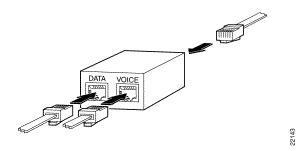
Microfilters
Microfilters are installed on telephones to improve voice call quality when voice and data equipment use the same telephone line (twisted pair). You should use microfilters when either of these two conditions exist:
-
The documentation for the telephone(s) you use with the router states that microfilters should be used with the phone.
-
Poor telephone call quality is resolved by installing a microfilter on the phone line.
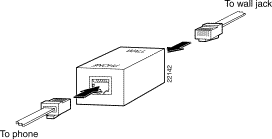
Common Splitter and Microfilter Configurations
This section describes the most common scenarios that use splitters and microfilters listed from most common to least common.
Telco-Installed Splitter
This splitter, also referred to as a network interface device (NID), is installed by the telephone company on the customer premises.
The router and telephone are on separate lines (twisted pair) to the splitter. They share the same telephone line (twisted pair) to the Telco. Microfilters are optional. They should be installed only if they improve telephone call quality.
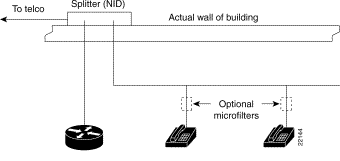
Customer-Installed Splitter
This splitter is installed by the customer on the customer premises. The router and telephone share the same telephone line (twisted pair) to the telco. Also, they are directly connected to the splitter. The splitter is connected to the telephone line.
For additional telephones connected through the splitter, microfilters are optional and should be installed only if they improve telephone call quality.
For telephones connected directly to the telephone line, microfilters are required.
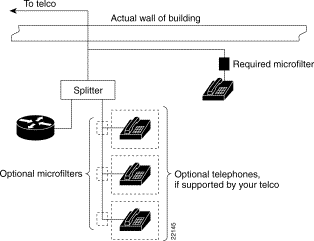
Router and Telephone Using Separate Telephone Lines
The router and telephone are connected to separate telephone lines to the Telco. The microfilter is optional. It should be installed only if it improves telephone call quality.
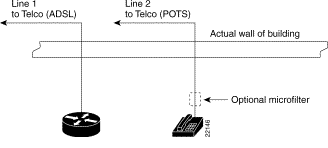
Related Information
Revision History
| Revision | Publish Date | Comments |
|---|---|---|
1.0 |
23-Nov-2007 |
Initial Release |
 Feedback
Feedback